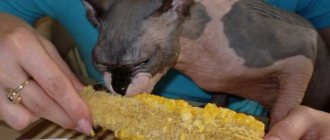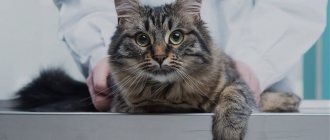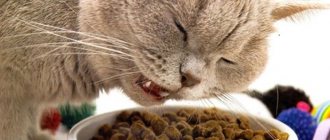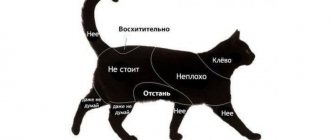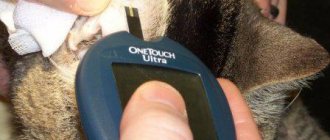Sterilization or castration?
First of all, the owner of the animal must decide what to do: sterilization or castration. These two procedures are different from each other. During sterilization, the ovaries are removed or the uterus is removed, but the ovaries are not touched. With this operation, estrus continues, but kittens do not appear. The animal's hormonal environment subsequently becomes unstable, and even in rare cases pregnancy is possible.
Castration is the removal of the uterus and ovaries. In this case, the production of estrogen stops, and hormones after such an operation become more stable because the adrenal glands are involved in the production of hormones.
How does the operation work?
During the operation, the animal is under general anesthesia. Seam position may vary. It may appear as a white line on the abdomen or as a small dot on the side. In the first case, such a suture is applied in the presence of inflammation. In the second, the operation is performed with early castration. The second operation is much simpler. In any case, the incision site must be treated constantly.
Poor operation
Owners often note that sterilized cats ask for a male cat even after oophorectomy. This may occur due to the fact that the organ is not completely removed. Rementant ovarian syndrome is a fairly common consequence of surgery to remove it. Sexual heat in this case is caused by tissue remnants from a poorly performed operation.
Part of the ovary (even a few cells) may secrete progesterone and other sex hormones, causing signs of estrus to appear approximately 2-3 months after surgery. The cycle will continue with the same frequency as before sterilization.
To eliminate the syndrome, repeated surgery is required.
Caring for animals in the first hours after sterilization
Let's look at how to care for a cat after sterilization. Once the animal has undergone surgery, the owner must surround it carefully and carefully so that the recovery period passes without complications. In the first hours after sterilization, the cat recovers from anesthesia . Monitor the animal's condition to avoid complications. Here are some points that may cause concern:
- If the cat lies motionless for a long time, and its nose and paws are very cold, you need to measure the temperature (insert a thermometer into the anus). A temperature below 37 ℃ is a reason to consult a doctor. It could be hypothermia .
- Continuous bleeding for more than 10 hours after surgery suggests the possibility of internal bleeding. You need to urgently contact a veterinary clinic.
- A high body temperature of an animal - more than 40℃ - is also an abnormal factor. Typically, a cat's temperature can be around 39℃ for 3 days, but no more.
- Swelling and inflammation of the suture can last up to 5 days . If this continues for more than a week, then you should show the animal to a veterinarian.
Postoperative care for a cat after sterilization is quite disturbing for the owner. For some time the animal is not controlled, so involuntary urination is possible . This is normal, so don't scold your cat. Vomiting is also . This should not bother the owner either. But if vomiting continues for more than two days, this is already a pathology.
During surgery, the cat's eyes are open. When you bring the animal, its eyes are still open. To prevent the mucous membrane from becoming dry, you need to instill a special solution.
In order not to dry out the eyes even if insisted, it is better to close and open them with your fingers at least once every half hour while the animals blink on their own.
It's the same with the mouth. To avoid drying out, you should periodically water your cat with a pipette. This must be done carefully so that the animal does not suffocate. You need a little water - a few drops. But you need to drink regularly, about every hour.
If the cat wants to go to the toilet, then it is better to help her. Place the animal in the tray and lightly support it under the belly with a towel. The cat is still very weak after the operation, so it will be difficult for her to cope on her own.
The sleepy state, in which the pet does not control its actions and moves in space, can last up to 12 hours . Drowsiness and loss of appetite may last up to 48 hours.
Some veterinary clinics may offer to leave your furry pet in the hospital , since caring for the cat in the first days after sterilization is very important and takes quite a lot of time. This proposal has its pros and cons.
Benefits of stationary monitoring
First of all, it is convenient in cold winter weather: there is no need to take the animal immediately after the operation, the cat will not freeze. Secondly, if you don’t have free time or the ability to care for an animal, this is a great alternative. All restoration work will be carried out by specialists. Thirdly, the possibility of harming the cat with improper care is excluded. This way you will protect your beloved pet from complications and side effects. Finally, if your furry pet has health problems, observation at the hospital will rule out pathology.
Disadvantages of recovery in hospital
Disadvantages include the stressful state of the animal when it finds itself in unfamiliar conditions. In addition, the cat may regard the owner’s behavior as betrayal , so restoring the pet’s trust will not be easy. The high cost of keeping an animal in a clinic can be harmful. And, of course, there is no guarantee that conscientious specialists work in a specialized institution that will promptly and regularly carry out the necessary procedures and keep animals in comfortable conditions. After all, only a loving owner can take good care of a cat after sterilization.
Hereditary factor
In rare cases, when a neutered cat asks for a male cat, the cause is a genetic abnormality. Ectopic ovarian tissue syndrome and an additional organ can cause estrus even after the removal of the cat’s reproductive organs. Anomalies are more common in purebred animals.
With ectopia, ovarian tissue may accidentally end up in different organs of the animal during intrauterine development of the kitten. After the operation, they produce sex hormones, and it is impossible to remove them from the body. Peculiarities of caring for such a pet include constant use of appropriate medications. If the anomaly is the presence of a third ovary, then the problem can be solved with additional surgery after ultrasound and detection of the organ.
Caring for your cat during recovery
Here are some important rules for caring for a cat after sterilization.
- In the first days after sterilization, it is necessary to limit the activity of animals, otherwise the seams may unravel. It is better to place the cat in a confined space - in one of the rooms where there is no special place to move. In this way, complications and re-operation can be avoided.
- Suture care after sterilization of cats is especially important. You have to do it right. The veterinarian who prescribes your cat will always give recommendations for scar care. Most often it is recommended to treat the seam with a special ointment or chlorhexidine . After 10 days, the stitches can be removed. Recently, clinics have begun to use self-absorbable materials. This is a big plus, because in this case the cat will not have additional stress when visiting the veterinary clinic again.
- It is necessary to conduct a course of antibacterial therapy to avoid infection or inflammation of the sutures. The drug is prescribed by a veterinarian.
- After the operation, a special bandage is put - a blanket . It is removed only when processing seams. This will protect the animal from unwanted licking at the incision site and, of course, from injuring the sutures. The blanket cannot be removed even at night. After removing the stitches, it is recommended to wear the blanket for another 2-3 days. This will make the healing process faster. It is better not to leave the cat alone in a blanket. It has strings that attach it to the animal's body. There is a danger that when a cat is left at home alone, after jumping, it can catch on a door or cabinet handle and get stuck. The consequences can be catastrophic.
- diet must be suitable for a quick recovery. canned food to the diet . The animal may be offered a special post-operative diet (produced by different manufacturers, such as Royal Canin or Eukanuba). Then, after about a month, you need to switch your pet to sterilized cat food . After the recovery period, it is better to limit the pet than to treat it, since neutered cats are prone to obesity. Veterinarians recommend a strict diet or a low-calorie diet.
Cat, cat and kittens
Seventy-six million cats in the United States are spayed or neutered, and for good reason. Spaying or neutering a cat increases its life expectancy, reduces the risk of developing mammary tumors and uterine infections, prevents unwanted litters of kittens (millions of unwanted cats end up in shelters and are euthanized every year), reduces their tendency to wander, and makes the cat more affectionate and friendly. However, the same hormonal and metabolic changes that result in these benefits can also contribute to a cat's overeating and loss of energy. When a cat is spayed, its hormonal levels change. Surgery can reduce energy requirements by up to 30% and increase appetite by 20%.
Decreased energy coupled with increased appetite leads to rapid weight gain (spayed/neutered animals are almost 3.5 times more likely to be overweight), and, in some cases, obesity . Owners may notice that their cat seems lazy, has a voracious appetite, constantly meows and begs for food, and this behavior may actually be a result of spaying and neutering.
After sterilization, a cat's metabolism slows down and this is reflected in its behavior. If after surgery the owner does not make the necessary changes to the daily diet of his pet, this leads to obesity in 70% of cases. It takes nine to ten weeks for a cat to adapt its body to reduced energy needs. During this period, the cat can gain 40-50% weight. The risk of obesity increases if the cat moves little and lives indoors without being outside. To avoid obesity, you need to follow some recommendations.
Weigh your pet regularly
Obesity occurs when excess weight is 20-30% of the animal's optimal weight. This means that a cat who weighed 4 kg before surgery will become obese if she gains another 1 kg. One must be vigilant because obesity can cause serious disorders such as diabetes and kidney stones. You can assess the cat's condition visually or by palpation (palpation), however, the latter method becomes quite difficult for cats with thick, long hair. We can talk about obesity if the cat’s ribs and spine cannot be felt. However, it is best to visit a veterinarian who will determine the optimal weight for your cat depending on its breed. A cat's weight when she reaches one year of age is considered her ideal weight and should be maintained throughout her life.
It is necessary to determine the cat's energy needs
A spayed/neutered animal requires only 75-80% of the food it consumed before surgery. His energy needs are lower, and if we continue to feed the pet in the same volume, this will, of course, lead to weight gain.
A neutered cat with a slow metabolism needs 60 kcal per 1 kg of body weight per day. If the cat is predisposed to obesity, this dose should be reduced by another 15-20%. The approximate dosage may not be correct, so use a measuring cup or scale.
It is very important not to pay attention to the behavior of those cats that constantly meow and ask for food. Divide your pet's daily diet into several parts, so you can satisfy your cat's requirements without increasing the amount of food consumed. No additional foods should be given, except for the daily portion of food - no milk, cream, leftovers from dinner, treats, etc.
Choose foods specifically designed for neutered cats or cats prone to obesity (they contain moderate amounts of fat and increased dietary fiber). By following this rule, you can reduce the caloric content of food, but at the same time the cat will feel full and overeat less. Food for sterilized cats prone to obesity should contain less than 10% fat.
Acidify your food
Neutered cats are predisposed to developing kidney stones, so acidified foods that acidify the urine are the best preventive measure against stone formation.
Ensure high-tasting food
Rapid weight loss can negatively impact your cat's health. If an animal refuses food for a long time, this can lead to liver problems. Thus, low-fat foods should still be highly palatable and stimulate appetite. You should not starve your cat! If she refuses the “light” food, offer her another one.
Finally
It is easier to prevent obesity than to treat it. Cat owners should be especially sensitive to the needs of their pets after sterilization. It is important to choose the right food and give it rationally. Today, the range of food is quite wide; everyone can find what suits them best, depending on the lifestyle and activity of their pet.
Read more about cat sterilization
After some time, a neutered cat may still want to go for a walk. This is quite natural, because after surgery the animal releases hormones that are responsible for sexual desire. During this period, it is strictly forbidden to give special drops that discourage desire.
If the owner takes care of the cat after proper sterilization, then its recovery after sterilization will be easy and without side effects.
Usually, an operation in a proven and reliable clinic by an experienced veterinarian does not cause complications.
Proper care after sterilization is very important - it will help keep the cat healthy. If something in your animal's behavior bothers you, be sure to contact a veterinary clinic.
Behavior of a neutered cat
Initially, the operated animals were in a state close to lethargy. This behavior of a cat after castration is completely normal. It lasts several hours, after which the pet gradually recovers from anesthesia. Lack of appetite and thirst for 12 hours after castration is also normal.
Physical activity is contraindicated for one week after surgery.
You should try to prevent him from running, jumping and playing. At the same time, the cat should be comfortable. Experts recommend placing him in a small closed container where he can stand up to his full height and take different poses, but nothing more.
The bottom of the temporary house should be covered with something soft. It is better to place the cat on the right side to reduce the load on the heart. It is necessary to constantly monitor the animal - even during sleep. If you suddenly start vomiting, you may choke. Visiting the street and communicating with other animals or children immediately after sterilization are excluded. It is important to provide maximum love, care and peace.
At first, the cat may seem lethargic and passive. Aggression often occurs a few days after surgery. Neutered cats scream, usually rush or, conversely, move away from people. This is due to physical discomfort, as well as changes in hormone levels. Your pet's behavior should be treated with understanding and patience. When the rehabilitation period is over, the cat will become even more gentle than before.
Hormones
During the period from 2 weeks to 6-7 months after removal of the reproductive organs, the cat walks due to the presence of progesterone residues in the blood. Hormones that influence behavior are also produced by other organs: the pituitary gland and adrenal glands. The older the animal that was sterilized, the greater the likelihood of this outcome.
To solve the problem, you need to consult a veterinarian. To eliminate symptoms, the administration of a hormonal drug (Covinan, Depo-promone, etc.) is required. If you miss time, the cycle becomes permanent. But only a veterinarian can prescribe medicine and give an injection.
General care characteristics
After sterilization, cats look dirty. There may be blood on the fur. But bathing the animal for the first ten days is strictly prohibited . Avoid contact with water.
It is also very important to follow the following rules:
- do not give the animal any antibiotics;
- as a filler for the tray, use special store-bought sand, or even better, cut paper;
- change the filler and thoroughly “wash” the tray after each stool.
- Another important point that is very scary. After sterilization, animals often sleep with their eyes open. This is considered normal. To prevent drying out, you need to instill eye drops with a special solution. It is also recommended to close and open the animal’s eyelids every half hour while sleeping.
Caring for a cat after home sterilization requires not only patience, but also love.
Frightened and suffering from pain and hormonal changes, the animal needs affection. The owner’s emotional mood will help him survive this difficult period.
Particular attention – seams
Many modern veterinary clinics use special self-absorbing sutures during sterilization operations. In this case, the stitches should not be removed. If this procedure is still necessary, it should be performed by a doctor.
In young animals, only the internal organs are usually sutured, and special surgical glue is used on the outside. You need to make sure that the cat does not touch the protective cover.
You need to focus on the appearance that appears immediately after the operation.
Symptoms of anxiety:
- unpleasant odor coming from the seam;
- severe redness;
- exudate (fluid discharge);
- the seam is hot to the touch.
If you have any of the above symptoms, you should seek medical help. In the normal course of events, the sutures heal on their own, without intervention. In cases where the operation is carried out the old fashioned way, the doctor will tell the owner how to proceed. Chlorhexidine is considered the best treatment for stitches.
Feeding a cat after sterilization
Postoperative care for a neutered cat requires a special diet. As noted above, the animal usually does not eat or drink for the first 12 hours . But then you can offer him half the usual daily amount of food.
If the cat refuses to drink, it is recommended to use a pipette to pour in a small amount of liquid.
And to awaken your appetite, lubricate your gums with something tasty. The ideal option is sugar syrup, which you need to moisten a cotton swab with and give the animal the opportunity to lick.
Force feeding a cat after sterilization should not be done. In cases where several days have passed and she is not eating or drinking, you should consult a doctor. Most likely, the operation led to some complications. Although some animals simply react to stress this way, each organism is individual.
After sterilization, cats often experience constipation . We should try not to give animals food that causes them to appear. It is recommended to feed him something wet and drink plenty of water. If your cat doesn't go to the toilet for many days, she will need specialized help. It would be good to support your pet’s body with special vitamins for animals. They must be prescribed by a doctor.
In general, according to reviews, a cat needs on average about two weeks to fully recover from sterilization . There may be interruptions in appetite for 14 days. But then, when estrogens stop being released, the zhor attacks many animals. They begin to gain weight quickly.
Cats undergoing sterilization are much sicker than males. But if the operation is performed on time, then in most cases the animal is quickly rehabilitated and returns to normal life. Neutered cats walk the same way as before the procedure. At the moment, they will not attract the attention of "suitors". For several weeks after sterilization, the cat's body will not have hormones that cause libido.
How to organize proper nutrition for a sterilized cat
After surgery, there is no need to radically change the type of food your pet eats. If your cat is accustomed to eating natural products, then you should not look for a replacement in the form of ready-made food. Industrial feed should be treated more carefully than before sterilization. The food must be of high quality and specialized, that is, intended for sterilized cats.
Although, as mentioned above, cats have a complex relationship with the feeling of satiety, high-quality food will allow the cat not to leave her bowl hungry. Nutritious food rich in protein will allow your cat to temporarily forget about the need to eat.
To avoid gaining excess weight, cats, like people, need a proper diet. It is necessary to teach her that food appears in the bowl only in the morning and evening. The rest of the time it should remain empty. If the cat is accustomed to three meals a day, you can meet her halfway; however, the amount of food intended for the day should be divided into three feedings.
What else do you need to know
For a while, the cat litter should be replaced with paper . The fact is that particles of filler that get into the cut can cause infection. Also, after the operation, it is necessary to ensure that the suture does not bleed and is clean. If there is discharge, contact your veterinarian immediately as the wound may become infected. After sterilization, a cat requires special treatment. Pressing on the stitches may cause pain.
Sterilization for an animal is accompanied by great stress. In addition, the immune system weakens and the cat can be susceptible to various diseases, so you need to monitor its general condition: how much it eats, how it drinks, how it goes to the toilet.
two weeks for the cat to fully recover . When estrogen stops entering the body, pets begin to eat a lot. Metabolism slows down and the animal may gain weight. To prevent a cat from becoming obese, it is necessary that it moves more, you need to walk and play with it, and also provide food for its diet.

